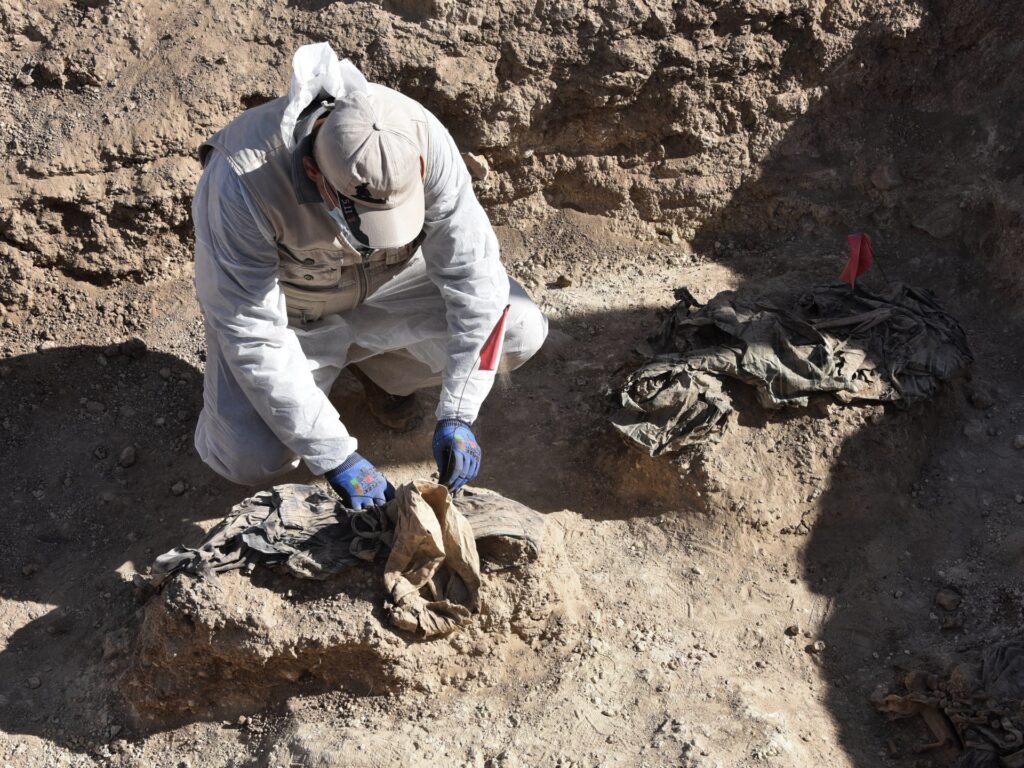970x125
The al-Khasfa site, near Iraq’s second-largest city, could contain 4,000 remains and possibly thousands more.
970x125
Iraqi officials have begun the excavation of what is believed to be a mass grave left behind by ISIL (ISIS) during its years of carnage exacted upon the civilian population after it seized large swaths of the nation from 2014 onwards, until being vanquished three years later.
Local authorities were working alongside the judiciary, forensic investigators, the Iraqi Martyrs Foundation and the directorate of mass graves to carry out the excavation in al-Khafsa, south of the northern city of Mosul, the state-run Iraqi News Agency reported on Sunday.
The site – a sinkhole about 150 metres (nearly 500 feet) deep and 110 metres (360 ft) wide – is believed to have been the grisly scene of some of the worst massacres committed by ISIL.
Ahmad Qusay al-Asady, head of the Martyrs Foundation’s mass graves excavation department, told The Associated Press news agency that his team began work on August 9 at the request of the Nineveh province.
The operation will initially be limited to gathering visible human remains and surface evidence, while preparing for a full exhumation that officials say will require international support, al-Asady said.
The foundation will then build a database and start collecting DNA samples from families of suspected victims.
Full exhumations can only proceed once specialised assistance is secured to navigate the site’s hazards, including sulfur water and unexploded ordnance. The water may have also eroded the human remains, complicating DNA identification.
Because of the presence of these elements, al-Khafsa is “a very complicated site,” al-Asady added.
Based on unverified accounts from witnesses and families and other unofficial testimonies, authorities estimate the site could contain at least 4,000 remains, with the possibility of thousands more.
Al-Khasfa is located near Mosul, Iraq’s second-largest city, where ISIL took control before being defeated in Iraq in late 2017. At its peak, ISIL ruled an area half the size of the United Kingdom, spanning across Iraq and Syria, with Raqqa in the latter being the capital of their self-declared “caliphate”.
The group was notorious for its brutality. The group carried out massacres of thousands of the Yazidi people and enslaved thousands of Yazidi women. The Yazidis, a long-persecuted group whose faith is rooted in Zoroastrianism, are still recovering from the horrors of ISIL’s onslaught on their community in Iraq’s Sinjar district in 2014.
Rabah Nouri Attiyah, a lawyer who has worked on more than 70 cases of missing people in Nineveh, told the AP that information points to al-Khasfa being “the largest mass grave in modern Iraqi history”.
Al-Asady, however, said investigators have not yet been able to confirm its size.
About 70 percent of the estimated human remains there are believed to belong to Iraqi army and police personnel, as well as other victims, including Yazidis.
Interviews conducted with numerous witnesses from the area suggest ISIL fighters brought people there by bus to kill them. “Many of them were decapitated,” al-Asady said.
In addition to ISIL-era mass graves, Iraqi authorities continue to unearth such sites dating to the rule of Saddam Hussein, who was toppled in a US-led invasion in 2003.
970x125

